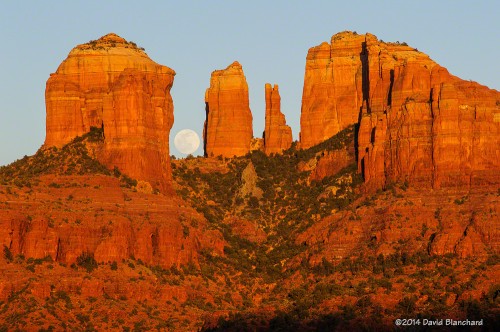The last two days have presented some interesting opportunities to photograph the moon under vastly different lighting.
The day before the full moon (27 September 2015) was a chance to shoot the moon as it rose between the pillars of Cathedral Rock in Sedona, Arizona. Timing and location was determined using The Photographers Ephemeris. Shooting the moon the day before the full moon ensures that the moon has risen high enough to clear the rocks and that there is still good lighting on the rocks.
As always, I get a little nervous as I wait for the moon to rise from behind the rocks. Did I get the location right? Usually I’m pretty close and only have to move a short distance in one direction or the other; this time I didn’t have to move at all. Whew! A couple of photographers from Flagstaff joined me for this event. It was their first time “Shooting the Moon” at Cathedral Rock and they had a great time.


The main event came a day later with the lunar eclipse. This month’s full moon was also a so-called “Supermoon” which means that the moon was at perigee (closest approach). A full moon at perigee is visually larger up to 14% in diameter and shines 30% brighter than one at its farthest point (apogee). But since the moon was moving through the Earth’s shadow during the eclipse, brightness wasn’t really all that important.

The shadowed moon was dark enough that I was able to capture several stellar occultations during totality. This image was taken just a few seconds before the star HIP 1601 at the upper left limb of the moon was eclipsed. For this image, I used the iOptron Skytracker so that I could take longer images without streaking the stars or moon.
Just moments later, bands of thin cirrus clouds invaded the sky.







